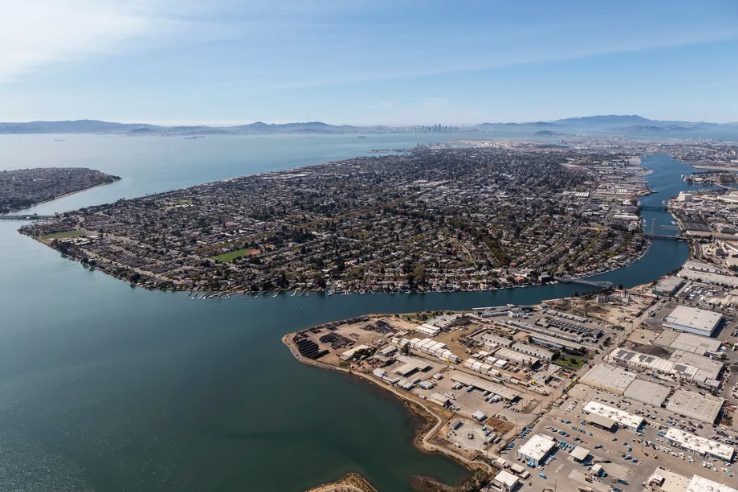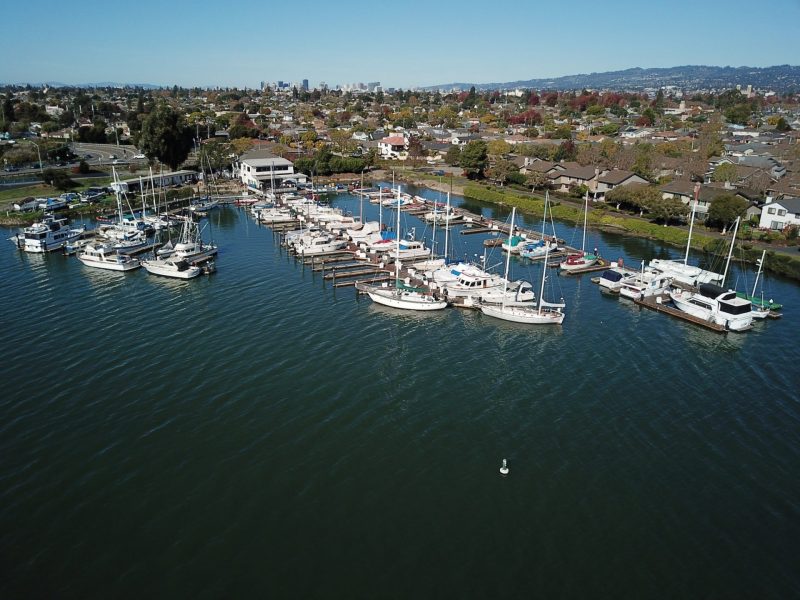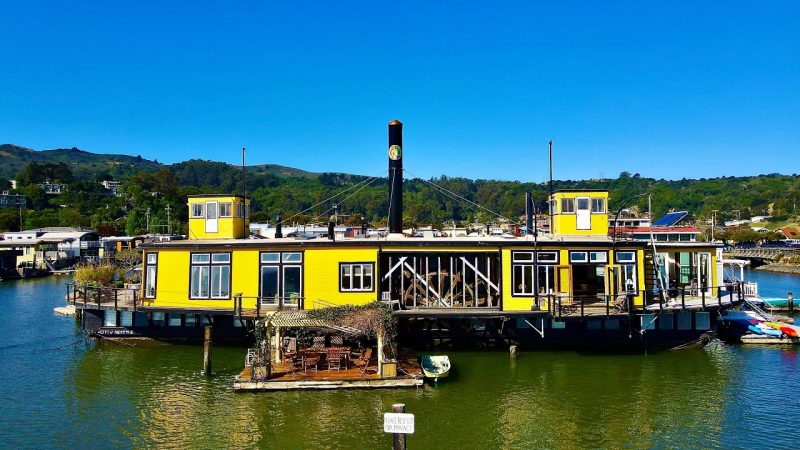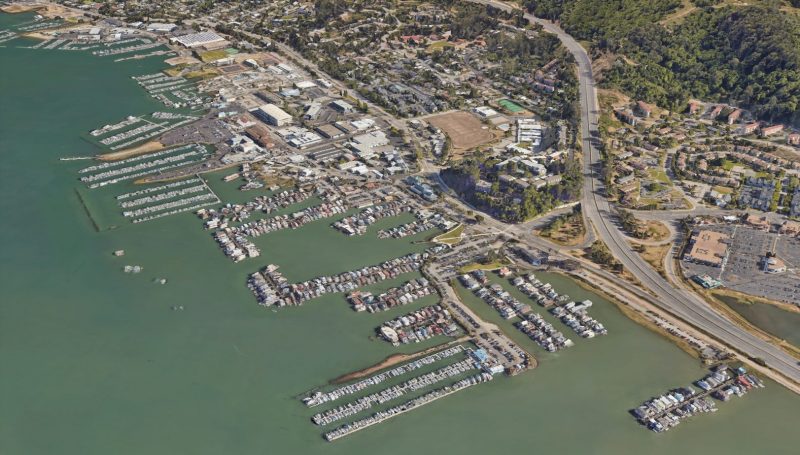
Rent Control Comes to Bay Area Floating-Home Marinas. Are Liveaboards Next?
After an Alameda houseboat marina proposed raising berth rates this summer, a series of events at both the city and state level have led to rent control for the majority of floating homes — about 500 — in the Bay Area. Alameda also considered offering tenant protections for all liveaboards on any vessel in city waters, but will take the next year to study the idea.
Both an Alameda and a California rent-control bill have been heralded by some people in the liveaboard community, and met with opposition from marina owners and managers, many of whom said they felt excluded from the process of crafting legislation.
As the housing crisis continues to put pressure on the maritime ecosystem, people who live aboard boats, as well as marina owners, are being affected in a variety of ways, and in some cases are becoming polarized against each other. The on-the-water life that many people have enjoyed for decades is being redefined in the frenzy of the housing market.

Proposed Liveaboard Protections in Alameda
There are two distinct but related issues at play: the debate over floating-home rent control, which is now a statewide bill on the books (though it applies to only three Bay Area counties), and the proposal to extend tenant protections to all liveaboards in Alameda.
After purchasing Barnhill Marina and Boatyard from the namesake Barnhill family in late 2021, the new owner, Amar Narang and Valley Investments LLC, announced a rent increase by an average of about 30%, which they say would still be below market-rate berth fees. Set against an industrial zone, Barnhill is the only floating-home marina on the Oakland Estuary, and everyone seems to agree that Alameda and Sausalito represent vastly different markets for floating homes.
Responding to the increase in April, Alameda extended the city’s rent-stabilization ordinance and COVID-19 eviction moratorium to approximately 60 residents, according to the Mercury News. In July, the Alameda City Council held a meeting to discuss amending the rent-control ordinance, which included the term “other maritime residential tenancies,” the Alameda Post reported. This meant all liveaboards, and not just floating homes.
“Without any public hearing or consultation with boat marinas, or solicitation for any input, the city retroactively included liveaboards into the [ordinance],” Kris Leverich, the commodore of the Aeolian Yacht Club, which has several liveaboards, told us.
“After first receiving notice from the city in mid-June that they must immediately register as landlords and comply with shoreside housing regulations, we thought, ‘This must be a mistake.’ All of the marinas and affected yacht clubs mobilized a response locally with supportive boaters to push back.” Leverich helped form the Alameda Marine Coalition, which he called an informal group representing marina managers and owners.
At a mid-July meeting, the Alameda City Council voted to defer the liveaboard-protection question for one year to undertake further study, but the non-floating-home liveaboard protections were granted to vessels at only Barnhill, and no other Alameda marinas.
At the July meeting, “100% of public attendees from the boating community decried the disaster which would unfold if marina managers effectively lost control of their harbors,” Leverich told us. “No public speaker spoke in favor of the measure.”
“[Harbormasters] had some legitimate concerns,” Michael Rousch, a special counsel with the City of Alameda who was involved in negotiations this summer, told us. “They need to have the ability to deal with the situations with liveaboards as they occur. Our intent is to see if we need to draft local legislation, and draft it in a way that doesn’t impair their ability to run the marina.”
With an election approaching, the City of Alameda’s stance on liveaboard protections might change with a new council. Rousch commented, “We’re hoping that the new city council knows that [marina managers] exist as one of their constituencies, and that they’ll just pick up a phone or shoot us an email.
“If they had done that to begin with, it would have headed off a lot of conflict.”

The potential Alameda ordinance was proposed at the same time that longtime liveaboards in Oyster Cove Marina in South San Francisco were given notice to evict, showing two extremes faced by a portion of the liveaboard community — some people have no protection as renters, while others now have broad shielding of their status as tenants.
Regarding the Alameda proposal, Leverich told us that, “From a practical and legal standpoint, [liveaboard protections] by the city would lead into a quagmire of conflicts with maritime law, and likely jeopardize not only the viability of recreational marinas in Alameda, but give every marina in the Bay reason to reconsider extending liveaboard privileges.
“Pursuing boating as housing is a dead end, and it’s dangerous in a number of ways,” Leverich added. “Given the housing crisis, we need to have alternative ways of looking at vulnerable people on boats and reducing risks rather than amplifying them.”
Rent Caps for Floating-Home Marinas
Signed into law in late September, California bill AB 252 imposes rent control on nearly 480 floating-home berths across Alameda, Contra Costa, and Marin counties, and will cap the amount a marina owner can increase berth rent per year to 3% plus the cost-of-living adjustment, or 5%, whichever is lower. According to one floating-home manager, AB 252 would also prohibit marinas from raising berth fees when a floating home is sold to a new owner.
“We’ve been advised that being prohibited from increasing berth fees for new owners is unconstitutional, because we own the property and it would be a deprivation of use of our own property,” Becky Smith, the property manager at Waldo Point Harbor in Sausalito, told us.
AB 252 said that “There is no known opposition” to the bill, though a number of floating-home marina owners and managers have told us that they emphatically object to additional rent control. (In 2019, California bill AB 1482 limited annual increases on all homes, whether on land or sea, to no more than 5% plus any change in the local Consumer Price Index, or 10%, whichever is lower.)
“We didn’t know anything about the legislation until the very last minute; we found out when it was presented to the Assembly. There was no type of conversation,” Smith told us.
“There’s no wrong that needs a right,” said Chris Tellis, the harbormaster at Yellow Ferry Harbor in Sausalito, which has 22 floating homes. “AB 252 is faux progressivism. Over the decades, houseboat values in Marin have skyrocketed, while we kept the berthage rate in check under the terms of the leases. Houseboat berthage on a square-foot basis is cheaper than recreational marinas. At Yellow Ferry Harbor, we have leases that go to 2051. No one has ever heard of rent control in the richest county in America, and that’s not even residential housing,” Tellis said, adding that the average berth fee at Yellow Ferry is around $1,500.

We’ve heard estimates that the median price of floating homes in Sausalito hovers around $1.5 million, which is roughly the median home price in the Bay Area in general. In some cases, floating homes are second homes or rental properties.
AB 252 asserts that people living in floating homes are “one of the most economically diverse populations in our region, including many seniors and others living on low and fixed incomes. Floating homes provide some of the only naturally occurring affordable housing for healthcare workers, crafts and trades people, artists and civil servants.”
With 282 homes, Waldo Point Harbor in Sausalito is the largest floating-home marina in the Bay Area, and one of the largest in the country. “We have 38 low-to-moderate-income floating homes that we subsidize ourselves,” said Becky Smith.
(We asked Assemblymember Mia Bonta, who authored AB 252, and whose district encompasses Alameda, Oakland and San Leandro, to what extent floating homes represent affordable housing. [We also asked why AB 252 covers only three counties, and doesn’t include San Francisco, San Diego, etc.] We did not hear back from her office.)

Both a floating-home owner and a few floating-home harbor owners and managers told us that their way of life is potentially under threat — the homeowner said they could not afford an increase in berth fees, and that the equity that they’ve accrued is in danger, while the owners and managers said they could not sustain their businesses if they weren’t able to raise berth fees.
“There’s a misconception some residents have that the harbor makes so much money, and we don’t,” Becky Smith said, “If this bill is enforced, we may have to sell the harbor due to financial concerns.”
“This bill passes on the real property value to the tenants while reserving the taxes for the landowners,” Chris Tellis said. “We have already spent $30k to redo the entrance and parking landscaping; the budget was around $200k. But we are tabling these plans,” wrote Tellis in a letter.
“Unlike other rent-control ordinances, there is no provision to pass through the costs of improvements or adaptations to climate change. The Bay is expected to rise 1-3 feet in the lifetime of our leases. This will require raising the docks, utilities, and parking lot — basically rebuilding the entire marina. AB 252 assumes the marina owner is going to singlehandedly shoulder the cost of rising sea levels on behalf of all the tenants. That’s not going to happen when the marinas are not even allowed to keep up with the current round of inflation.”
Paraphrasing a floating-home owner: “It’s ridiculous to assume that people who have floating homes have the means to pay for climate-change infrastructure.”

Another great article by Tim Henry about a very important local and possibly state-wide issue.
It seems to me that the issue that just made it’s way through the Alameda City Council and compelled the residents of ALL of the floating home communities to craft California AB252 might never had been enacted if the new owner of Barnhill Marina had kept his word and only raised the berth rents at 10% and communicated with the residents honestly. We are not idiots, we understand that the rent had to go up but this owner came in with a sledge hammer and attempted raise the rents on some of us as much as 85% and up to 150% for others. He pretty much thought he might be able to do that every year! This man and his investors own apartment building in the Valley and it would appear that they felt they could swoop into a 50-year-old community of homeowners and treat them the same as he did his renters. He was wrong. He totally mishandled a situation that has left him, his daughter, his investors at odds with all of us in the community. I dare say we would have likely be amenable to some assessments over time to help repairs docks and some other infrastructure needs. But, he choose not to do that and voila, two bills have been passed, City & State, which will keep us all, and please excuse the pun, afloat. This is not over and the ramifications statewide have hardly been discussed. Meanwhile, those of us who live here do so without leases, without the certainty that we can sell our homes should we need or want to move and walk on failing docks without any sense of when life might return to some sort of normal. I am one of those well over 60 year old residents on a fixed income. I’m an active volunteer in this community of Alameda. But, it’s quite likely that I will need to move in the next few years as age, climate change and king tides create conditions that could prove difficult for me to navigate. The question is…will I be forced out before that time comes?? And, if so, will my investment in this charming home be able to be sold for enough to sustain me? Uncertain times.
Some of the confusion surrounding AB 252 is because it was crafted to protect “floating home” slips as opposed to boat slips. Floating home is a legally defined term (see California Health and Safety Code – HSC § 18075.55n.), and is quite different from houseboats, powerboats, or sailboats. Most importantly, floating homes do not have motors built into them and rely on local sewer and utility lines.
Not being mobile, the BCDC considers Floating Homes to be “bay fill.” (bcdc.ca.gov/planning/reports/HouseboatsAndLiveAboardBoats_Jul1985.pdf), and ruled that there are a fixed number of floating home slips, and that there will never be any more than there are today.
The upshot of this is that floating homes, unlike houseboats, powerboats and sailboats, have no other slips to move to.
So if a marina owner were to raise slip rents exorbitantly, the floating home owner can’t just move the house to a different location; an exorbitant increase in slip rent could make it difficult to impossible to sell. This would constitute constructive eviction, an illegal action a landlord takes when they do not physically or legally evict a tenant, but takes actions that interfere with the use of the premises. This is the exact situation floating home owners face.
Although the author of the article references the rental protection passed through California Code 1482, marina owners responded that that protection was trumped by admiralty law (covering marine matters), which has jurisdiction over county and state laws. However, in the 2013 Lozman case, the US Supreme Court ruled that floating homes indeed were not vessels and would not be covered under admiralty law.
Therefore, I feel that AB 252 provides much needed protection for the vast number of floating home owners.